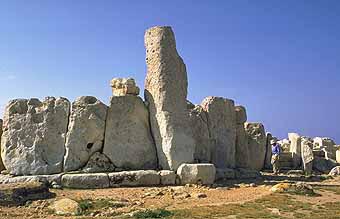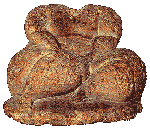
Hagar Qim, Malta
Episode 1:
"Wisdom of the Stones: Life in the Neolithic
Age" ©2000
51 min., 2000, VC 3906, pt. 1

Mother Goddess
Hagar Qim, Malta |
In this program, anthropologist Richard
Rudgley strives to roll back the limits of history to
include the remarkable achievements of the Neolithic Age.
Engineering skills, as demonstrated by the temple of Hagar
Qim and the Hal Saflieni Hypogeum, in Malta; indications
of well-developed religious systems; evidence of acupuncture
techniques; examples of bookkeeping via clay tokens; and
proof of an intricate social structure through the digs
at Çatal Höyük and Asikli Höyük,
in Turkey, reveal the depth and the genius of the Neolithic
peoples. Architect Richard England, writing specialist
Denise Schmandt Besserat, and others support Rudgley’s
thesis with expert analysis.
|
Episode 2: "Frozen
in Time: Life in the Upper Paleolithic Age""
©2000
51 min., 2000, VC 3906, pt. 2
Anthropologically speaking, social complexity and technological
skill are generally considered recent human developments. Could
these qualities have appeared much longer ago than previously suspected?
In this program, anthropologist Richard Rudgley shatters the stereotype
of life in what is commonly referred to as the Ice Age. Findings
such as a prehistoric bead factory, a cave cathedral, and beautifully
sculpted female figurines sketch a plausible portrait of a society
in which women and children were equal to men and daily tasks required
being just as intelligent as humans are today.
Terms / Concepts
Notes
Episode 3: "The
Human Story: Traces of Humankind's Oldest Relatives"
51 min., 2000, VC 3906, pt. 3
In this program, anthropologist Richard Rudgley presents the
results of his research into Neanderthal society, skewering
the popular misconception that Neanderthals were subhuman. After
a visit to Israel, where Neanderthals and Cro-Magnons once coexisted,
Rudgley travels to Portugal, where he talks about the 24,500-year-old
skeleton of a child that appears to be a Neanderthal/Cro-Magnon
hybrid. Finally, seeking back even farther in time, he examines
the few remaining clues to the thoughts and lives of humankind’s
most distant relatives: some ochre stains, shaped stones, and
tools crafted with fossils embedded in their handles.
Terms / Concepts
Notes
Terms / Concepts / Features
- single-season sites
- year-round sites
- cold climate adaptation
- speech
- burial rituals
- "The Neandertal problem"
- art
- "The Grandmother Revolution"
Notes
- obsidian
- volcanic glass
- the world's oldest mirrors
- Dr. Tristan Carter (obsidian specialist)
- Cappadocia
- Upper Paleolithic -- "The
Ice Age"
- glaciers covered up to 30% of the earth
- rivers were a key feature in all of ice age life
- they were living in communities of 20 - 25 people
- but they must have met once in awhile, like at Mas d'Azil
-
-
Copper: 3,300 B.C.
-
Bronze Age: 2,200 B.C.
- "Dawn of Writing" 3,100 B.C.
- Ötzi The Iceman
- Finland today is at the edge of the polar ice cap
- Ice age hunters left a trail of food which shows that they
were our intellectual equals
- if they were not knowledgeable they would have been dead
- foothills of the Pyrenees in Southern France
- 30,000 ybp this was the land of the hunter
- the Upper Paleolithic diet may have only been 20% meat
- the other 80% was probably provided by the women
- the women and children probably collected berries,
leaves, fruits, vegetables and some meats (like rabbits. . . .)
- they were making beads out of wooly mammoth ivory and
soapstone
- beads may be made in two sites, in two stages
- they produced beads to a standard size of only 6 mm
- these were probably done by the women
- the greatest technological advance in the Pleistocene
was control of fire
- this was the first rung on the ladder to metallurgy and
eventually to the industrial revolution
- the image of the hunter providing for his family is only half
the story. The contributions of the women must be considered
- prehistoric art
- Homo erectus
left Africa ca. 1.8 mya, not 1.0 mya
- "Grandmother Revolution"
- child care was shared and women were increasingly able
to play an expanded role in society
- textile technology existed near 30,000 ybp at a high level
of sophistication
- this is generally a female activity
- there are textiles represented on female statuettes through
Europe, including the "Venus figurines
Cultures
/ Sites
- Egypt
- Mesopotamia
- Stonehenge
- Malta
- Temple of Hagar Qim
- Hal Saflieni Hypogeum
- known only as "The Temple Builders"
- 5,000 - 2,500 B.C.
- Bolzano, Italy
- Ötzi "The Iceman"
- 3,300 B.C.
- ca. 46 when he died
- tattoos -- acupuncture
- Çatal Höyük
- 7,000 B.C.
- 10,000 people
- world's oldest mirrors
- Cappadocia
- Central Turkey
- Source of Obsidian
- Asikli Höyük
- Portuguese Boy
- Vezère Valley
- Dolni Vestonice
- Upper Paleolithic
- Czech Republic
- ivory female figurines
- some of the most precious treasures of the Old Ice
Age
- Niaux Cave
- French Pyrannies
- "Hall of the Black Bison"
- Schöengen, Germany
- 400,000 ybp
- wooden spears
- "The Wood Age"
- "The Stone Age wasn't the stone age at all."
- "The Wood Age" is as old as imaginable."
- Lascaux
- Israel
- Shanidar
- fossil pollen
- 50,000 ybp burial
- "Nandy" (Creeb)
- Strait of Gibraltar -- Morocco
- Pech Merle
- Pergouset Cave
Individuals
- Richard Rudgley
- Dodi Ben Ami (Paleolithic technologist)
- John Shea (archaeologist)
- Yoel Rak (anatomy)
- Erella Hovern (archaeologist)
- Jaõo Silão
- Ralph Solecki (Shanidar)
- Robert Bednarik (marine archaeologist)
- thinks humans could have made boat voyages as early as 1 mya
- Daniel Quinn (Civilization and Beyond?)
- Olga Soffer ("Grandmother Revolution")
- Michel Lorblanchet (prehistoric art)
- Frank Bahr(accupuncture)
- Denise Schmandt Besserat (writing)
- Tristan Carter (obsidian)
- Richard England
Publications / Bibliography
E-mail Address
|

